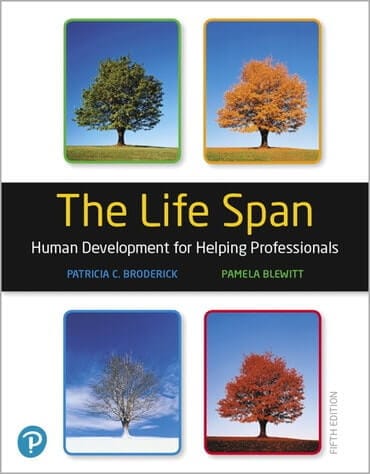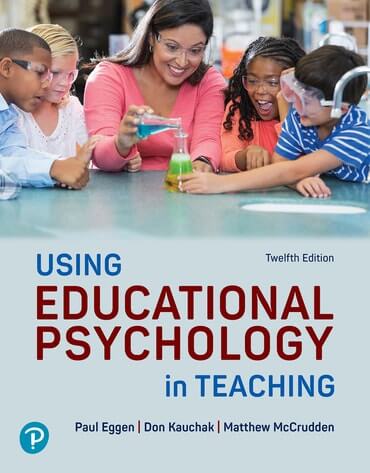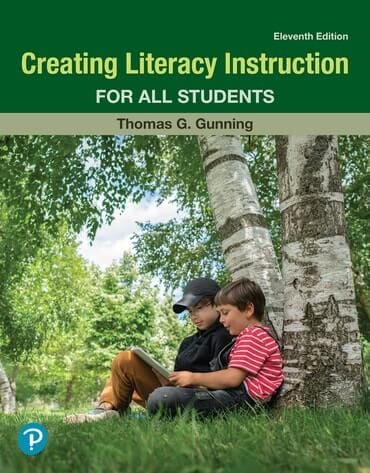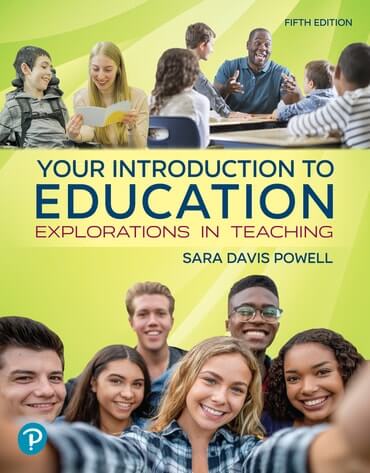Dr. MaryEllen Vogt will present a brief overview of the SIOP Model, including its origin, rationale, and research support.
Teacher Education & Helping Professions
Set students up for success in their courses and careers
Course-specific resources by discipline

Pearson+
Empower students to choose how they learn best with easy-to-use eTextbooks and study tools, available in Pearson+.

Authentic integrated videos
Provide real-world context with authentic classroom or clinical videos integrated within many Pearson+ eTextbook titles.

LMS-compatible assessment bank
Streamline assignments and grading using a packaged file including quizzes, application exercises and chapter tests.
Visit your title’s product page to download the assessment bank

Get the eTextbook experience
Find your title in our comprehensive catalog and request complimentary access to an eTextbook, available in Pearson+.








Explore titles for education, social work, counseling, and communication disorders.
Featured news
Congratulations to these amazing authors for their accomplishments. Learn more about how these Pearson authors have been recognized.
Anita Woolfolk Hoy, for being an AERA Presidential Citation 2023 award recipient
Kristin Gehsmann, who was named Dean of Clemson University’s College of Education

Anita Woolfolk Hoy
author of Educational Psychology, 15th Edition

Kristin Gehsmann
author of Teaching Reading and Writing: The Developmental Approach, 2nd Edition
Join author Dr. Adam Jordan to learn how assessment can be used as a tool for inclusion and teacher empowerment. Includes overview of responsibilities and practical applications of concepts.
Join Drs. William L. Heward, Sheila Alber-Morgan, and Moira Konrad for a discussion on nine ethical requirements for effective special education teachers.
-
Why eTextbooks are gaining popularity in Higher Ed
There is so much breadth and depth to what Pearson can do to help you and your students achieve the best learning outcomes. Consider the following features and benefits that eTextbooks offer. And learn why a growing audience of instructors and students are taking advantage of our remarkable Pearson+ subscription capabilities. In fact, nearly 5 million subscribers have embraced the Pearson+ subscription platform.
To begin, we will focus on eTextbooks. They are more popular than ever. Don’t just take our word for it. A great deal of research over the past five years shows that well-designed digital content can be understood as effectively as print and offers added benefits for students.*
Remember, not all of your students are fully acquainted with all the capabilities of eTextbooks. Take the time at the beginning of your next course to be sure you communicate all the features and benefits of any new eTextbook, as well as Pearson+.
Affordability
In many cases digital eTextbooks are up to 80% cheaper than traditional printed textbooks. With our Pearson+ platform, students can subscribe to their course etextbooks at one low monthly rate or pay for the semester upfront. At the end of their subscription term, students have the flexibility to cancel, renew, or change titles to accommodate their learning needs. Pearson offers a range of features that appeal to a variety of learning styles. The user experience is elegant and intuitive. Naturally that means the navigation makes it easy for students to make their way through the content. Many of our etextbook titles have embedded audio and video to engage students and help them understand difficult concepts in the course. Full audiobooks are available for most titles which can help with comprehension, retention, and gives students the option to listen on the go.
In addition, no one should underestimate the value of adjusting the speed of any audio. Certain students may choose a slower speed, but many prefer to accelerate the audio for more efficiency. In addition, a student listening may strengthen comprehension further and even activate the highlighting of the text in sync with the audio.
Interactive features like charts and diagrams make it easier for students who may prefer to explore and analyze such engaging visuals.
Interactivity strengthens how students study
Markup and additional interactive features make it easier for studying than ever before. They can customize the display of content. And students are happy to know that once they return to any content, the eTextbook remembers where they left off and the learner can dive right back in.
Additional benefits for studying include:
- Notetaking
- Pre-built flashcards**
- Create your own flashcards
- Highlighting
- Bookmarking
- Adjusting the point size of the text
And the robust enhanced search engine even offers an excellent sub-menu referencing groupings of relevant videos, key terms and interactive media. In fact, Pearson+ is exploring a possible new etextbook feature regarding the way students learn, from an individual experience to a social one. Students can see who else is studying, start discussions and post links and videos. The social experience within the eTextbook is global, giving all users the ability to engage. The experience is not limited to students in a certain class at a specific university.
Encourage your students to learn in the way they learn best.
Content Mastery
A study by the Bill and Melinda Gates Foundation found that when students take courses that engage digitally and in-person, content mastery can occur twice as quickly, and pass rates for at-risk students can increase by 33%.
Pearson+. Anywhere, anytime
The Pearson+ subscription platform is the ideal way students can access eTextbooks. Among other compelling features, with Pearson+ they can consolidate all their eTextbooks, videos, audio, study tools, and supportive content all in one place. Naturally, this allows your students to work more efficiently.
There’s an app for this
With the Pearson+ mobile app, students can pick up at any point where they left off and learn on the go. Learners can easily read offline right in our app. So they can have more freedom to make the most of their day. Here are some of the main reasons the platform and the app are so appealing.
Once selected, they have immediate access to the content. Students can learn on the go (with online and offline access). They can learn with their eTextbooks wherever life takes them. Pearson+ offers students instant access to their eTextbooks, videos and study tools, all in one place. With easy access through a subscription or their MyLab® or Mastering® course, our intuitive interface, enhanced search, highlights, notes, and audiobooks allow them to choose how they learn best.
Meet your students where they are
So why not meet students where they are, figuratively and literally. Everyone knows they are often on the run. The content is optimized for a learner’s phone or another mobile device. It’s a no-brainer for today’s tech-savvy generation. Your students are certainly accustomed to processing information from smart phones and other mobile devices.
We are also mindful of working learners. The convenience of Pearson+ gives them the flexibility to learn wherever and whenever best suits their needs and their busy work schedule. Any student on the go can listen to an eTextbook while cooking, cleaning, driving or while tackling whatever task happens to be in front of them.
Lastly, be sure to take full advantage of our grade-technology too. It’s a familiar feature for your class and a time-saver for you. So you can focus on additional priorities.
Go ahead. Be the best instructor you can be. Learn more about eTextbooks and Pearson+ today.
*Webinar: https://www.pearson.com/us/about/news-events/events/2021/12/digital-reading-in-the-modern-world.html
** Available in most titles
-
ChatGPT, YIKES!!!
Preventing cheating is a challenge we all face today given not only students’ ingenuity, but also the available student tools on the internet that publish tests and answers from many, many courses. And now there is... ChatGPT!!!
Although it may be difficult to prevent cheating entirely, there are steps that can be implemented, reducing the impact of cheating for the student learning assessment process for online courses.
I’d like to share with you the practical tips I found from Northern Illinois’s Center for Innovative Teaching and Learning. These tips may help reduce cheating for the two most common uses of online learning assessments, which are testing and homework assignments.
Tips for testing – using learning management systems
Purposefully select assessment methods
Use online objective tests like multiple choice, multiple answer, true/false are best implemented for lower stakes assessing student learning. In fact, these types of quizzes are often best used as student self-checks in preparation for higher stakes assessments.
When assessing student mastery of course goals and objectives, objective tests may not be the best option considered among a range of methods. While an objective test can measure a student’s ability to recall or organize information, other methods are far preferable for assessing the higher order/critical thinking skills including understanding, applying, analyzing, evaluating, and creating.
Mix objective and subjective questions
Online testing using multiple choice, multiple answer, true/false, fill in the blank might be a part of a summative assessment of mastery that also includes short answer or essay questions.
These types of questions are more subjective in nature and demand a deeper understanding of the subject matter. Consider questions that allow students to demonstrate higher order thinking skills with the application of principles learned for unique situations. While mixing objective and subjective questions does not stop information sharing, it can limit the impact on the student’s final grade.
Create your own question pools
Rather than using a fixed number of items that remain unchanged for each administration of the test, consider creating a question pool using any institution’s learning management tools.
Group questions by any number of criteria including topic, subject matter, question type or difficulty of the question. I would also suggest grouping questions according to the learning outcome associated with the question.
A pool will generate an assessment with randomized questions selected by the faculty member. Pools can be created from new questions or those in existing tests or pools. Pools are most effective when there are large numbers of questions in one particular group. For example, one might have a pool of true/false questions, another of multiple choice and a third for fill in the blank.
You might create an assessment drawing a specific number of questions from each of those pool categories. Faculty can also add new questions to pools each time the course is taught to expand the variability of questions. Conversely, older questions can be removed.
Randomize questions
When creating a test using a learning management system, you are often given the option to randomize the selection of test questions as well as the order in which they appear. The benefit is that students are unlikely to get the same questions in the same sequence when taking a test.
This strategy addresses the issue of students who take a test at the same time in order to share answers. This is also relevant if faculty allows students to repeat the test. Each time this occurs, a test will be made up of questions that are randomly selected and ordered.
Limit feedback
When possible, you should limit what types of feedback are displayed to students upon completion of a test. Providing test scores is important feedback that indicates how well students have performed and should be made available. However, through a process of elimination, students may be able to determine the correct answer for each test question if their submitted answers are identified as incorrect. Or if the correct answer is provided.
Students could lose the incentive to both prepare for testing or to seek correct answers by reviewing lecture notes, assigned readings, or through a group discussion after completing tests. Thus, faculty might reconsider whether to include ‘Submitted Answers’ as an option to be displayed to students.
This is especially relevant if faculty have allowed students to repeat tests. Each time a test was taken, students could attempt a different answer for a test question that was previously graded as incorrect. Correct answers to all test questions could eventually be accumulated and passed on to other students, or to students of future classes. Or answers could be posted to some online site where students can access exams from a vast number of courses and subjects.
Set timer
We have to recognize that students taking an unproctored exam are free to use open book/notes. So you might decide to use time limits if allowed in the learning management system. Students who adequately prepared for a test may well be less likely to rely on open book/notes compared with students unprepared for testing. By setting a test with an expected completion time, unprepared students could have the most to lose as they spend time going over material, and risk not having sufficient time to respond to all the test questions.
Display questions one-at-a-time
If a test has more than 5 questions, do not choose the ‘All at Once’ option for displaying all the questions on the same screen. It is quite easy for students to take a screen capture of the displayed questions and share them with other students. While students can still screen capture pages with single questions, or even type them into a document, it is more time consuming and unwieldy.
Tips for homework assignments: assessing student progress and mastery
Create application assignments
Create assignments that require students to apply essential course concepts to a relevant problem. This encourages students to seek relevant information beyond the assigned readings and lectures and conduct independent research by identifying credible sources to support the development of their assignments.
Students can be required to report their progress on a regular basis through email, or through the journaling assignments offered in any Revel titles. This documentation makes it easier for faculty to see the development of a student’s work from inception to completion. In addition, it may possibly identify unexplained gaps that could occur if students used the work of others and claimed it as their own.
Faculty can add input at any point in this process to provide guidance, and perhaps suggest new directions for students. Both documentation of progress through regular status reporting and occasional faculty input can add a greater level of scrutiny to students. This can make it more difficult to pass off the work of others as their own. I use this method in my psychology courses by using my learning management system’s Discussion Forums. I require responses that use proper APA and documentation as well as student to student comments.
Create group assignments
Create group assignments that require students to interact with group members regularly. Groups can be made responsible for determining the functional roles for each member, establishing a mechanism for accountability (i.e., submitting weekly progress reports), and sharing drafts of individual progress on a group project. For a project to be truly collaborative, each group member should be familiar with everyone else’s work, and be able to describe how every group members’ contribution supports the whole group assignment.
Students who are using the work of others may not be able to adequately describe the significance of their ‘own’ work, or how it contributes to the group’s overall project. Group projects for me have been improved with online students using the Revel tool, Shared Media. I’m able to group students and have them submit a shared document or recording for evaluation.
Create assignments that require presentations
Conduct asynchronous online assignments for class presentations. This is easily accomplished with the same Shared Media tool in Revel. I have been using this video upload tool for over 13 years with my public speaking students.
Students may be asked to submit a progress report or use a Journal to reflect on what they have learned in the past week that supports work toward the presentation. You might consider using a discussion forum for these progress reports where classmates can contribute to one another.
To further scrutinize work on the presentation, students may be asked to include time for questions and answers. Students who have developed the presentation should be comfortable answering a range of topic-related questions from an arranged audience. I required my speech students to have an audience of 7 adults and include a Q&A that is captured on video as well as their speech presentation.
Check for plagiarism using SafeAssign
SafeAssign is a remarkable plagiarism prevention tool that detects matches between students’ submitted assignments and existing works by others. These works are found on a number of databases including ProQuest ABI/Inform, Institutional document archives, the Global Reference Database, as well as a comprehensive index of documents available for public access on the internet.
SafeAssign can also be used to help students identify how to attribute sources properly rather than paraphrase without citing the original source. Thus, the SafeAssign feature is impressive and effective as both a deterrent and an educational tool.
Using any of the Writing Assignments in the Revel tool can have this Safe Assign evaluate any submission for plagiarism.
Use discussion assignments
Creating Discussion Board assignments require students to demonstrate critical thinking skills by responding to a relevant forum topic.
You may also design a rubric that is specific to the Discussion Board assignment and develop questions that require students to respond to every rubric category.
Having assignments that are very specific makes it more difficult for students to use portions of a previous term paper or other sources.
Include academic integrity policy statement in the course syllabus
As faculty we need to include a policy statement regarding academic integrity in the course syllabus.
In addition, reiterate academic policies for students taking an online course and clarifying guidelines for completing tests and assignments so that students are not confused about what they can and cannot do.
While this, in and of itself, may not be sufficient to change behavior, its acknowledged presence in the syllabus acknowledges a commitment to honesty in the academic arena. It also establishes the clear expectation that academic integrity is an important principle to live by.
Faculty may also choose to mention this policy using the ‘Announcements’ feature in any of your learning management systems, or while conducting a live web conference session.
Learn More
Preserving academic integrity is an ongoing challenge for traditional face-to-face, blended, and courses that are entirely online. While a number of expensive technology solutions, such as retinal eye scanners and live video monitoring have been developed to prevent cheating in online courses, the practical recommendations above can reduce the impact of cheating on assessing student performance online.
-
Teaching with social media: How to use tech to communicate with students
This blog series highlights educators who have embraced social media in their ongoing quest to meet students where they are, increase engagement, and improve results. Through these stories, you’ll discover how they got started, learn a few tips to make your foray into social media as seamless as possible, and hear some advice about incorporating these new technologies and platforms into your instruction or institution.
Social media helps my students engage with me and buy into the course a little more.
Plus, social media allows me to share a lot of real-life examples with students. I’m always looking for authentic learning experiences that show students more than just what we see in the abstract lecture — things that impact real life. YouTube™ allows me to extend the boundaries of the classroom, because I can upload short videos about lectures from the class.
Be willing to adapt
Don’t be afraid to evolve with your students. For instance, I don’t use Facebook much myself anymore. But that was the first place I used to upload examples and make it a resource — I could communicate with students where they were, rather than telling them to go into the LMS.
And ten years ago, students were certainly on Facebook more than they were on our LMS. But students have changed. They don’t use it that much anymore, so neither do I. It evolves every semester.











